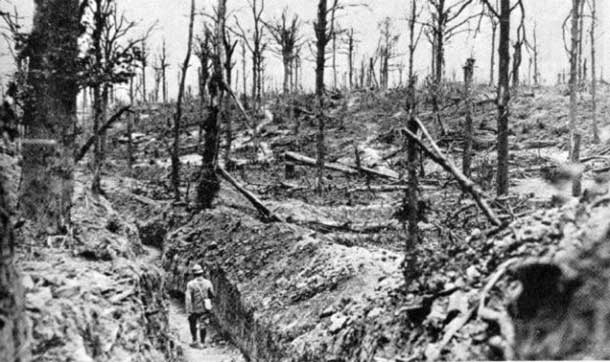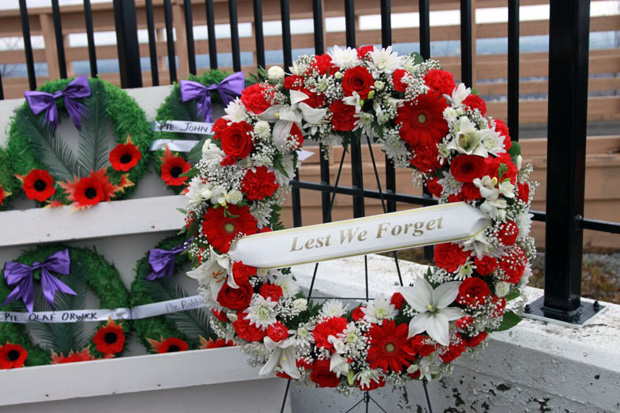by Peter Rasevych
LONGLAC – OPINION – Remembrance Day thoughts: An important point to make regarding World War II (1938-45) is that Indigenous peoples in North America fought on the side of the Allies because Great Britain (and also Canada with the USA) are those with whom treaties were signed, or are those with whom we Indigenous peoples in North America had/ have agreements with.
If the Axis Powers (Nazi Germany, the Italian Empire, and Imperial Japan) would have been successful, then the nation-to-nation relationship with our treaty signatory (Great Britain) would no longer have existed (even though Great Britain was an imperial, colonizing nation against us, they were and still are a treaty partner with First Nations in Canada).
The First Nations peoples here would simply have NO treaty relationship, with anyone at all, if we came under Axis Power rule. That was another reason why First Nations peoples fought so hard on the side of the Allies and were the best soldiers — as attested to by so many of their comrades with whom they died, as well as so many others on the various battle fronts.
This was despite the fact that First Nations peoples in Canada were not even eligible for conscription (we were not even Canadian citizens; we were not even permitted to vote in Canadian elections until 1960; we were not really even considered “people” in Canada). First Nations peoples were 100% volunteers. This is our own “national narrative” that, of course, is not heard often enough in mainstream Canada…why?
Because it is First Nations-based, and dominant mainstream Canadian discourses either blatantly ignore us, or at best marginalize us, or at worst are outright racist against us. This is why First Nations place our own “national narrative” on such a high pedestal, and quite proudly. Some Canadians do wonder about that.
Canada’s Cree-language “code talkers” changed the outcomes of the war, as did the Navajo-language “code talkers” from the USA. There are so many other ways that Indigenous peoples have influenced Canadian success in military efforts. Contributions of Indigenous peoples to the war efforts of the past have yet to be fully recognized by our current colonizers, who are our treaty partners.
Unfortunately, the First Nation veterans who returned home to Canada after World War II was over, came home to a place where they were still disregarded as less than people — this after they had just sacrificed their lives as equals to other Canadian citizens (some First Nation veterans actually had served in World War I a few decades before, and some were high-ranking officers in World War II), as equals to the other Canadian soldiers on the battlefields, in the various theatres of war overseas.
Here in Canada, it was back to the same Canadian racism for them — to be cast out and treated as less than people in their own lands and territories. This is the era when Canada experienced massive economic development, growth, prosperity and expansion (1940’s and 1950’s particularly) — and this is the very time that in the Town of Longlac, where I write this, Anishnawbe people were shunted off of their lands, the best lands where homes and businesses in Longlac now are situated, to make way for Longlac to expand and prosper.
This economic growth entailed taking advantage of Anishnawbe people in the Longlac area, whom they regarded as not even people, by exploiting our lands and resources. This was so that Longlac people could establish businesses, corporations, economic development, economic growth, massive wealth and prosperity during a booming time.
Anishnawbe families in the immediate Long Lake area were pushed off to the fringes, outside of town, as Longlac grew exponentially based on a lands and resources exploitation-based economy (forestry, mining, hydro-electric development, aggregates, etc). The Trans-Canada Highway was constructed through the town, and while Longlac prospered by greater and greater increments each year, local Anishnawbe families lived in abject third-world poverty on the First Nation reserves outside of the town.
Longlac became a town of only a few houses in the early 20th century, to a booming population of thousands of people after World War II. But Anishnawbe people were shunted away from their family use areas, that are today covered over by the town’s streets.
The local First Nations in the Longlac area were not included in any of the benefits whatsoever, from the 1940’s and 1950’s massive natural resources development, as per treaty promises. We were excluded completely, forced to watch others prosper on the wealth that they derived from our own lands and resources. This still continues, for decades and decades, to this day. It is still happening in 2018.
Under the Government of Canada’s federal Indian Act statute (1876), as some are aware, it was simply not possible for “Indians” to accomplish such things such as being business owners, corporation executives or even hiring a lawyer. In fact, there were many, many things that “Indians” were prohibited from doing. Including attending post-secondary education. This is why one of the greatest victories for us is to have our children complete high school and then move on to post-secondary education.
I see that many Canadians are totally unaware of that fact. The fact that Canada is rooted in draconian legislation that controls the lives of First Nations peoples. This is still the case in many ways, and it can be seen by anyone in the Town of Longlac today.
Canada’s 1876 Indian Act legislation was/is so successful, that the framers of the evil, white supremacist South Africa Apartheid regime (1948-94) visited Canada to utilize the same basic structure to colonize blacks in South Africa. Hitler’s racist, white supremacist Nazi Germany utilized many of the same concepts to control Jewish people in Jewish Ghettoes in Europe during World War II.
There are many similarities. Like the Jews in Nazi Germany, First Nations peoples in Canada were not permitted to own businesses, among other things.
“Pass laws” were a way for black people to get around in South Africa until 1986. Similar to the “pass system” imposed on First Nation peoples here in Canada, it was a way to control the movements of people, to segregate them from non-Indigenous people, and to confine them into one area (in Canada, “Indian Reserves,” in South Africa, “Homelands”).
This is all very similar to the Jewish Ghettoization that occurred in Nazi Germany during World War II. There were hundreds of anti-Jewish laws that were passed, that served to restrict all aspects of life, including basic human rights as well as political, legal, and civil rights. Yes, this was Longlac in the 1940’s and 1950’s. And today in 2018.
“This is Canada, though,” people say…we don’t do that here. We are not white supremacists.” Yes, Canada is just as bad. One needs to examine the facts. Why don’t people attack Canada for its mistreatment of First Nations, the same way that people attacked South African Apartheid, to end that regime there in 1994? Or the way that people attacked Nazi Germany for its mistreatment of Jewish people?
For Anishnawbe Word War II veterans then, returning home to Longlac, it was to be subjected to the same old Canadian racial discrimination that they had experienced before they left Canada, to go overseas. They came back to a place, Longlac, where they were subject to many of the same conditions that they had just given their lives to fight to end for others, overseas. They had to watch non-Indigenous local Longlac townspeople and businesses thrive, they had to watch multinational corporations prosper through development of their lands, while they sat on the reserves outside of Longlac, excluded from this wealth and growth.
One can imagine how they must have felt, to be valued as equal human beings in other parts of the world during World War II, to be treated as heroes even, but then to come home to Canada (or as I say, Longlac, Ontario) and to be subjected to the same institutionalized racial discrimination and systemic oppression, that exists in mainstream Canadian institutions and structures, that STILL persists here in Canada today.
The views, opinions and positions expressed by all columnists and contributors are the author’s alone. They do not inherently or expressly reflect the views, opinions and/or positions of NetNewsLedger.







